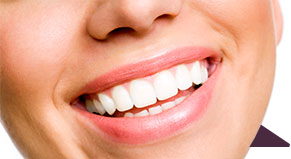Can Flossing Cause Gaps Between Your Teeth?
February 23rd, 2017

Flossing has become a controversial topic, thanks to the latest report from the U.S. departments of Health and Human Services and Agriculture. In its most recently released Dietary Guidelines for Americans, flossing is not included as part of a daily health regimen. However, the departments, alongside the American Dental Association (ADA), Center for Disease Control and others, reaffirmed that flossing helps prevent tooth decay and gum disease.
According to the ADA, interdental cleaners, such as floss, remove plaque and food debris that can lead to cavities or gum disease from the areas that a toothbrush can’t reach. The ADA recommends brushing teeth for two minutes twice a day as well as flossing to clean between teeth once a day.
Does Flossing Cause Teeth Gaps?
Flossing is often overlooked due to convenience (we know you’re busy!) or misinformation despite the recommendation to floss daily. In fact, some think that flossing can cause gaps between your teeth and skip flossing altogether.
While you can experience gaps in between your teeth when flossing, the gaps do not occur because flossing itself is harmful. Instead, gaps can occur due to flossing mistakes and improper flossing such as cutting your gums.
Common Flossing Mistakes That Can Lead to Teeth Gaps
You Cut Your Gums.
Forcing the floss in between the teeth causes the floss to snap down and cut your gums. Not only is this painful, but it can cause the gums to recede overtime and create—you guessed it—gaps in between your teeth.
You Stop Flossing When Your Gums Bleed.
Gums often bleed because plaque on the teeth irritate and inflame the gums. If your gums bleed when you floss, it is a sign you have built-up plaque that needs to be removed or have gum disease.
How to Properly Floss Your Teeth
If you are experiencing gaps between your teeth, you may just need to properly floss your teeth, in addition to your twice daily brushing and regular dentist office visits every six months.
Start by breaking a string about 18 inches of floss. Then, wind most of it around your middle fingers on both hands. Hold the floss tight between your thumbs and forefingers.
Now guide the floss gently between your teeth using a sawing motion. Remember to avoid snapping and forcing the floss into the gums, which can cause irritation, bleeding and even recessed gums and teeth gaps over time.
Bend the floss into a C-shape around the tooth when the floss reaches the gum line, allowing the floss to reach all the way to the base of the tooth.
Next, rub each side of the tooth gently using up and down motions as you move the floss away from the gums. This helps remove any built-up plaque or trapped food particles.
Keep moving to another tooth using a clean section of floss every time. Be sure to floss the very last teeth all the way in the back—just because there isn’t another tooth next to them doesn’t mean plaque and food particles like to hide there too.
Finally, rinse with water or mouthwash.
Flossing every day is essential to your oral health. Without flossing, built-up plaque can lead to tooth decay, cavities, gum disease, and even gaps in between the teeth.
If you continue to experience problems flossing or have any questions, visit Water Tower Dental Care or contact us to schedule an appointment. We can take a look at your teeth to see if there are any serious issues and teach you the proper way to floss.


 Flossing is one of the more overlooked (and frequently skipped) steps to good dental hygiene. Dentists agree it’s an essential part of dental care. But if it seems like your floss is getting stuck between your teeth more often than your food does, it’s tempting just to brush your teeth and skip flossing. Don’t do it!
Flossing is one of the more overlooked (and frequently skipped) steps to good dental hygiene. Dentists agree it’s an essential part of dental care. But if it seems like your floss is getting stuck between your teeth more often than your food does, it’s tempting just to brush your teeth and skip flossing. Don’t do it! When you’re fast asleep, the last thing you’re thinking about is your teeth. (Unless you’re having a dental dream, of course.) So it’s important to make sure that your teeth are well protected before you hit the hay for a long night of sleep. We’ve put together a short checklist that you can use every night before you go to bed to keep your teeth protected all night long.
When you’re fast asleep, the last thing you’re thinking about is your teeth. (Unless you’re having a dental dream, of course.) So it’s important to make sure that your teeth are well protected before you hit the hay for a long night of sleep. We’ve put together a short checklist that you can use every night before you go to bed to keep your teeth protected all night long. Flossing has been making headlines recently thanks to the U.S. departments of Health and Human Services Agriculture’s Dietary Guidelines for Americans. The most recently released guidelines did not include flossing, which was once a recommended activity for daily health. But does this mean
Flossing has been making headlines recently thanks to the U.S. departments of Health and Human Services Agriculture’s Dietary Guidelines for Americans. The most recently released guidelines did not include flossing, which was once a recommended activity for daily health. But does this mean  You might consider brushing and flossing your teeth everyday a pain. But it’s definitely not as painful as it used to be. Throughout history, humans have experimented with a variety of different tools and ingredients to clean their teeth, including bones and oyster shells. The toothbrushes, toothpastes and floss we use today were created relatively recently.
You might consider brushing and flossing your teeth everyday a pain. But it’s definitely not as painful as it used to be. Throughout history, humans have experimented with a variety of different tools and ingredients to clean their teeth, including bones and oyster shells. The toothbrushes, toothpastes and floss we use today were created relatively recently. The last thing you want is yellow teeth after years of wearing braces. But unfortunately, it’s a very common occurrence. If you don’t take care of your mouth while you’re wearing braces, you might be surprised to see white squares where your braces were on yellow-stained teeth after your dentist removes them. Thankfully, it’s easy to avoid this experience. Here are some reasons why people get yellow teeth after braces and how to prevent this from happening. We’ll also talk about how you can fix stained teeth after braces.
The last thing you want is yellow teeth after years of wearing braces. But unfortunately, it’s a very common occurrence. If you don’t take care of your mouth while you’re wearing braces, you might be surprised to see white squares where your braces were on yellow-stained teeth after your dentist removes them. Thankfully, it’s easy to avoid this experience. Here are some reasons why people get yellow teeth after braces and how to prevent this from happening. We’ll also talk about how you can fix stained teeth after braces. When it comes to choosing dental floss, there are a lot of options out there. Picking the right type of floss will make your flossing experience easy, smooth, fast and effective. We here at Water Tower Dental Care are here to help break down all of the different choices so that you can choose the best floss for your teeth.
When it comes to choosing dental floss, there are a lot of options out there. Picking the right type of floss will make your flossing experience easy, smooth, fast and effective. We here at Water Tower Dental Care are here to help break down all of the different choices so that you can choose the best floss for your teeth.





 Website Powered by Sesame 24-7™
Website Powered by Sesame 24-7™